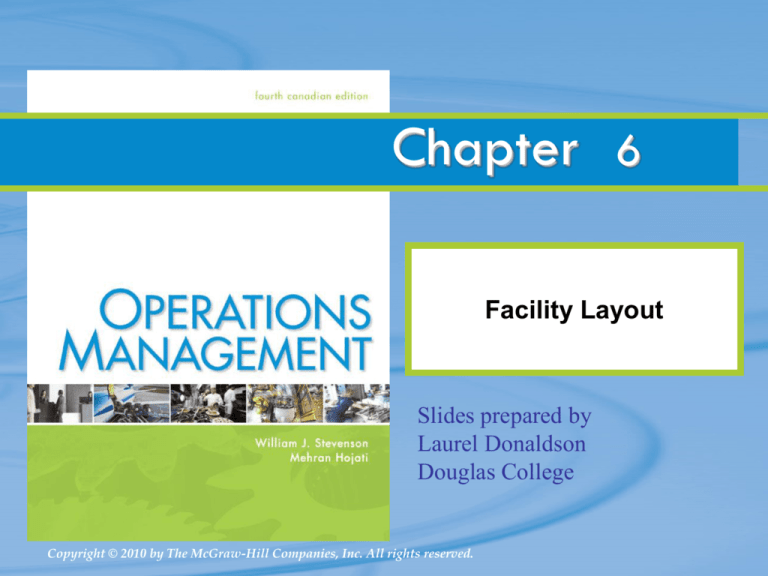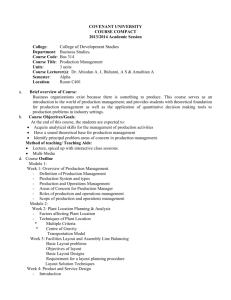
Chapter 6
Facility Layout
Slides prepared by
Laurel Donaldson
Douglas College
Copyright © 2010 by The McGraw-Hill Companies, Inc. All rights reserved.
Learning Objectives
LO 1
LO 2
LO 3
Describe the basic plant/facility layout types.
Solve simple assembly line balancing problems.
Develop simple process (functional) layouts.
Copyright © 2010 by The McGraw-Hill Companies, Inc. All rights reserved.
2
Chapter Outline
Types of Layout
Assembly Line Balancing
Designing Process Layouts
Copyright © 2010 by The McGraw-Hill Companies, Inc. All rights reserved.
3
Layout
Layout: the arrangement of departments,
work centers, equipment, etc.
want to have smooth movement (of work,
people, materials, info) through the system
LO 4
Copyright © 2010 by The McGraw-Hill Companies, Inc. All rights reserved.
4
Basic Layout Types
Product layout
arranges
production resources linearly
according to the progressive steps
by which a product is made
Process layout
arranges production resources together
according to similarity of function
LO 4
Copyright © 2010 by The McGraw-Hill Companies, Inc. All rights reserved.
5
Product (Line) Layout
Raw
materials
or customer
Material
and/or
labour
Station
1
Material
and/or
labour
Station
2
Material
and/or
labour
Station
3
Station
4
Finished
item
Material
and/or
labour
Used for Repetitive or Continuous Processing
More common for goods than services
LO 4
Copyright © 2010 by The McGraw-Hill Companies, Inc. All rights reserved.
6
Product Layout
(Assembly Line)
Standardized
processing operations
to achieve
smooth, rapid, high-volume flow
Standardized product/service
allows continuous processing and
specialization of labour & equipment
Product demand is stable
enough to justify high investment in specialized equipment
Divide work into series of tasks
by technological processing requirements
Can use fixed path material handling
conveyors
LO 4
Copyright © 2010 by The McGraw-Hill Companies, Inc. All rights reserved.
7
Product (Line) Layouts
Advantages: Efficient and Easy to Use
1. High degree of labour & equipment utilization
= lower cost per unit
2. Minimal work-in-process inventories
3. Simplified accounting, purchasing and inventory control
4. Easier training and supervision
Disadvantages: Inflexible
1.
2.
3.
4.
LO 4
Higher equipment cost
Dull, repetitive jobs = stress, low morale
Lack of flexibility in product or production rates
Work stoppage at any point ties up the whole operation
Copyright © 2010 by The McGraw-Hill Companies, Inc. All rights reserved.
8
Assembly Lines
Lucy at the Chocolate Factory
LO 4
Copyright © 2010 by The McGraw-Hill Companies, Inc. All rights reserved.
9
Process (Functional) Layout
Used for Intermittent processing
Job Shop or Batch Processes
Common in Services
LO 4
Copyright © 2010 by The McGraw-Hill Companies, Inc. All rights reserved.
10
Process (Functional) Layout
LO 4
Like machines
& equipment
are grouped
together
Flexible and
capable of
handling a
wide variety of
products or
services
Used for
intermittent
processes
(job-shop,
batch, most
services)
General
purpose
equipment and
variable-path
equipment
(forklift, pallet
jack, tote)
Copyright © 2010 by The McGraw-Hill Companies, Inc. All rights reserved.
11
Process (Functional) Layout
Advantages: Flexibility
Less vulnerable to shutdown
(from mechanical failure or absenteeism)
Lower maintenance costs
(and reduced investment in spare parts)
Disadvantages: Inefficiency
Scheduling can be difficult
(= low equipment utilization rates)
Setup, material handling, and
labour and costs can be high
Increased work-in-process
inventory
LO 4
Copyright © 2010 by The McGraw-Hill Companies, Inc. All rights reserved.
12
Cellular Layout
Cellular layout
Layout in which machines are grouped into a cell that can
process items that have similar processing requirements
Group technology
The grouping into part families of items with similar design
(size, shape and function) or manufacturing (type and
sequence of operations required) characteristics
LO 4
Copyright © 2010 by The McGraw-Hill Companies, Inc. All rights reserved.
13
Comparison of functional and cellular layouts
333 Lathes
Drill
Grind
Heat
treat
111
Gear
cutting
Functional Layout
LO 4
333
Assembly
111
222
222
Mill
333
111
444
222
111
444
111
222
Copyright © 2010 by The McGraw-Hill Companies, Inc. All rights reserved.
111
444
14
111
Lathe
222
333
Mill
Mill
Drill
Drill
Lathe Mill
444
Mill
Heat
treat
Gear
cut
111
Heat
treat
Grind
222
Heat
treat
Grind
333
Drill
Gear
cut
444
Cellular Layout
LO 4
Copyright © 2010 by The McGraw-Hill Companies, Inc. All rights reserved.
Assembly
Comparison of functional and cellular layouts
15
Cellular Layouts
Benefits:
faster processing time and reduced setup times
increased capacity
less material handling and work-in-process
inventory
Conversion is a major undertaking
Three primary methods:
visual inspection,
examination of design and production data,
and production flow sequence and routing analysis.
LO 4
Copyright © 2010 by The McGraw-Hill Companies, Inc. All rights reserved.
16
Other Layout Types
Warehouse layouts
Important consideration: frequency of order
Retail layouts
Important consideration: traffic flow
Office layouts
Objective: optimize the physical transfer of
information or paperwork
New trend: create an image of openness
(low rise partitions)
LO 4
Copyright © 2010 by The McGraw-Hill Companies, Inc. All rights reserved.
17
Fixed Position Layouts
Layout in which the product or project
remains stationary, and workers, materials,
and equipment are moved as needed.
Nature of the product dictates this type of
layout
Weight
Size
Bulk
Large construction projects
LO 4
Copyright © 2010 by The McGraw-Hill Companies, Inc. All rights reserved.
18
Design Product Layouts: Line Balancing
process of assigning tasks to workstations
so that the workstations have
approximately equal time requirements.
LO 4
Copyright © 2010 by The McGraw-Hill Companies, Inc. All rights reserved.
19
Line Balancing Procedure
Draw and label a
PRECEDENCE
DIAGRAM
Acceptable
efficiency?
Repeat if NO
LO 4
Calculate DESIRED
CYCLE TIME
required for line
Calculate
EFFICIENCY of Line
Copyright © 2010 by The McGraw-Hill Companies, Inc. All rights reserved.
Calculate theoretical
MINIMUM NUMBER
OF
WORKSTATIONS
GROUP Elements
into Workstations
• Cycle Time and
Precedence
CONSTRAINTS
20
Cycle Time
Cycle time is the maximum time
allowed at each workstation to
complete its set of tasks on a unit.
LO 5
Copyright © 2010 by The McGraw-Hill Companies, Inc. All rights reserved.
21
Line Balancing Formulas
OT
Output capacity
CT
OT operating time per day
CT cycle time
N min
N min
OT
CT
D
D desired output rate
t
CT
Theoretica l minimum number of work stations
t sum of the task time s
LO 5
Copyright © 2010 by The McGraw-Hill Companies, Inc. All rights reserved.
22
Precedence Diagram
Tool used in line balancing to display
elemental tasks and sequence requirements
0.1 min.
1.0 min.
a
b
c
0.7 min.
LO 5
A Simple Precedence
Diagram
d
0.5 min.
Copyright © 2010 by The McGraw-Hill Companies, Inc. All rights reserved.
e
0.2 min.
23
Example 1: Assembly Line Balancing
Arrange tasks into three workstations.
Use
a cycle time of 1.0 minute
Assign tasks in order of the most number of
followers
0.1 min.
1.0 min.
a
b
c
0.7 min.
LO 5
d
0.5
min.
Copyright © 2010 by The McGraw-Hill Companies, Inc. All rights reserved.
e
0.2 min.
24
Example 1 Solution
Eligible
Revised
Assign Time
Task
Remaining
1.0
0.9
0.2
a, c
c
none
a
c
-
0.9
0.2
2
1.0
b
b
0.0
3
1.0
0.5
0.3
d
e
-
d
e
-
0.5
0.3
Time
Workstation Remaining
1
0.1 min.
a
c
0.7 min.
LO 5
Station
Idle Time
0.2
0.0
0.3
0.5
1.0 min.
b
d
0.5
min.
e
0.2 min.
Copyright © 2010 by The McGraw-Hill Companies, Inc. All rights reserved.
25
Line Balancing Rules
Some Heuristic (intuitive) Rules:
Assign the task with longest time
Assign the task with the most followers
Percentage of idle time
Idle time
N actual Cycle time
100
Efficiency 100 - Percentage of idle time
LO 5
Copyright © 2010 by The McGraw-Hill Companies, Inc. All rights reserved.
26
Example 1 Solution
Idle time
0.5
% of idle time
100
100 16.7%
N actual Cycle time
3 1.0
efficiency 100% 16.7% 83.3%
WS 1
0.1 min.
a
WS 2
1.0 min.
b
WS 3
c
0.7 min.
LO 5
d
0.5 min.
Copyright © 2010 by The McGraw-Hill Companies, Inc. All rights reserved.
e
0.2 min.
27
Example 2
0.2
0.1
0.3
a
b
e
0.8
0.6
c
d
f
g
h
1.0
0.4
0.3
Arrange tasks into four workstations.
Use
a cycle time of 1.0 minute
Assign tasks in order of the most number of
followers (then longest time)
LO 5
Copyright © 2010 by The McGraw-Hill Companies, Inc. All rights reserved.
28
Solution to Example 2
Station 1
Station 2
b
a
Station 3
e
f
c
LO 5
Station 4
g
h
d
Copyright © 2010 by The McGraw-Hill Companies, Inc. All rights reserved.
29
Variable Task Times: Solutions
Reduce
variability
Use buffer
inventory
between
work
stations
Leave some
idle time in
workstations
which have
random
times
Use parallel
work
stations
design the
jobs better
use higher
quality
material,
do preventive
maintenance
LO 5
Copyright © 2010 by The McGraw-Hill Companies, Inc. All rights reserved.
30
Bottleneck Workstation
1 min.
30/hr.
1 min.
30/hr.
2 min.
30/hr.
1 min.
30/hr.
Bottleneck
30/hr.
1 min.
60/hr.
2 min.
30/hr.
1 min.
1 min.
60/hr.
30/hr.
2 min.
30/hr.
Parallel Workstations
LO 5
Copyright © 2010 by The McGraw-Hill Companies, Inc. All rights reserved.
31
Treatment of Bottlenecks
LO 5
Copyright © 2010 by The McGraw-Hill Companies, Inc. All rights reserved.
32
Process (Functional) Layout Design
Arrange work centers so as to minimize
transportation cost, distance or time
Difficult to optimize
General rule:
Locate departments
with high interdepartmental flow
as close as possible
LO 4
Copyright © 2010 by The McGraw-Hill Companies, Inc. All rights reserved.
33
Designing Process (Functional) Layouts
Information Requirements:
1. List of departments
2. Projection of work flows
3. Distance between locations
cost per unit of distance to move loads
4. List of special considerations
Location of entrances, elevators
Need to be close (or far) from others
Reinforced flooring, room dimensions, etc
LO 6
Copyright © 2010 by The McGraw-Hill Companies, Inc. All rights reserved.
34
Designing Process Layouts
Tools
LO 4
Block
Diagramming
QUANTITATIVE
Minimize Non-Adjacent Loads
Relationship
Diagramming
NON-QUANTITATIVE
Based on Intuitive Preferences
Copyright © 2010 by The McGraw-Hill Companies, Inc. All rights reserved.
35
Example: Process Layout Design
Distance between locations (metres)
From
A
B
C
Location
To
A
—
20
40
B
20
—
30
C
40
30
—
Loads between departments (per day)
From
1
2
3
LO 6
Department
To
1
—
20
90
2
10
—
70
3
80
30
—
Copyright © 2010 by The McGraw-Hill Companies, Inc. All rights reserved.
36
Example: Interdepartmental Work Flows
for Assigned Departments
30
170
1
A
10
0
3
B
C
From/To
Loads
Distance
Loads X Distance
1-2
10
40
400
1-3
80
20
1,600
2-1
20
40
800
2-3
30
30
900
3-1
90
20
1,800
3-2
70
30
2,100
Total
LO 6
2
Copyright © 2010 by The McGraw-Hill Companies, Inc. All rights reserved.
7,600
37
Closeness ratings - Muther Grid
Muther suggests the following list of reasons for closeness:
1. Use same equipment or facilities
2. Share the same personnel
3. Sequence of work flow
4. Ease of communication
5. Unsafe or unpleasant conditions
6. Similar work performed
LO 6
Copyright © 2010 by The McGraw-Hill Companies, Inc. All rights reserved.
38
Learning Checklist
Process
Discuss considerations for make or buy decisions
Compare intermittent vs. repetitive processes
Discuss issues in automation
Describe the steps in production process design
Be able to draw a process flow diagram
Facility Layout
List the different types and key considerations in each
Describe advantages/disadvantages of product,
process and cellular layouts
Create a precedence diagram, calculate cycle time,
idle time and efficiency, balance a line
Use tools to create a process layout
Copyright © 2010 by The McGraw-Hill Companies, Inc. All rights reserved.
39







